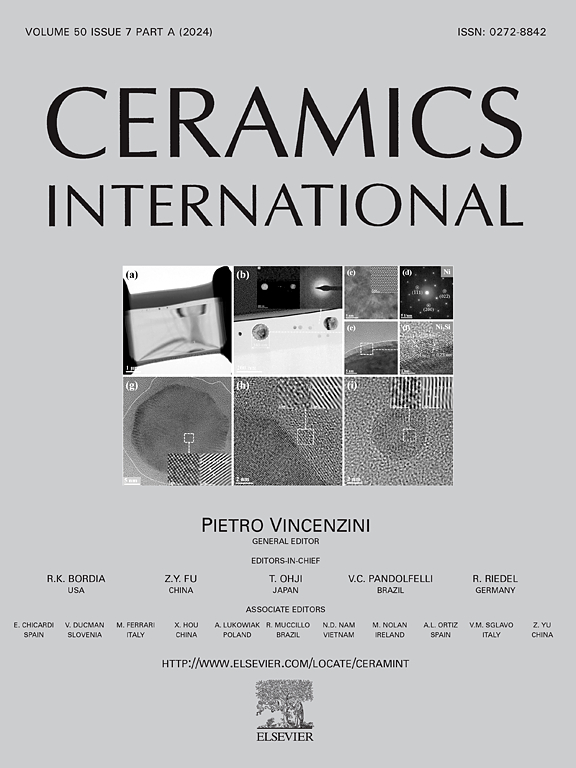Controllable morphology and enhanced luminescence in hydrothermally Cr3+-Doped Na3GaF6 phosphors for NIR imaging
IF 5.1
2区 材料科学
Q1 MATERIALS SCIENCE, CERAMICS
引用次数: 0
Abstract
Cr-doped fluorides are promising for near-infrared (NIR) imaging due to their broad emission spectra and tunable luminescence within low-phonon-energy matrices. However, achieving precise control over particle morphology to enhance luminescence remains challenging. This study employs hydrothermal synthesis to optimize the morphology and NIR emission of Cr3+-doped Na3GaF6 phosphors by varying synthesis parameters like temperature and surfactant type. Optimized conditions produced larger, uniform polyhedral particles that exhibited enhanced NIR emission (650–900 nm), peaking at 756 nm under 431 nm excitation. When used in a NIR phosphor-converted LED (NIR-pc-LED), the phosphors achieved a radiation flux of 28.88 mW at 320 mA and a photoelectric conversion efficiency of 2.73%, showcasing their potential for NIR imaging applications such as biological imaging and night vision technologies.
水热Cr3+掺杂Na3GaF6荧光粉用于近红外成像的可控形貌和增强发光
掺铬氟化物由于其宽发射光谱和在低声子能量矩阵内可调谐的发光而具有近红外成像的前景。然而,实现对粒子形态的精确控制以增强发光仍然具有挑战性。本研究采用水热合成法,通过改变温度和表面活性剂类型等合成参数,优化Cr3+掺杂Na3GaF6荧光粉的形貌和近红外发射性能。优化后的多面体颗粒尺寸更大,均匀,近红外发射增强(650-900 nm),在431 nm激发下,峰值位于756 nm。当用于近红外磷光转换LED (NIR-pc-LED)时,该荧光粉在320 mA时的辐射通量为28.88 mW,光电转换效率为2.73%,显示出其在生物成像和夜视技术等近红外成像应用中的潜力。
本文章由计算机程序翻译,如有差异,请以英文原文为准。
求助全文
约1分钟内获得全文
求助全文
来源期刊

Ceramics International
工程技术-材料科学:硅酸盐
CiteScore
9.40
自引率
15.40%
发文量
4558
审稿时长
25 days
期刊介绍:
Ceramics International covers the science of advanced ceramic materials. The journal encourages contributions that demonstrate how an understanding of the basic chemical and physical phenomena may direct materials design and stimulate ideas for new or improved processing techniques, in order to obtain materials with desired structural features and properties.
Ceramics International covers oxide and non-oxide ceramics, functional glasses, glass ceramics, amorphous inorganic non-metallic materials (and their combinations with metal and organic materials), in the form of particulates, dense or porous bodies, thin/thick films and laminated, graded and composite structures. Process related topics such as ceramic-ceramic joints or joining ceramics with dissimilar materials, as well as surface finishing and conditioning are also covered. Besides traditional processing techniques, manufacturing routes of interest include innovative procedures benefiting from externally applied stresses, electromagnetic fields and energetic beams, as well as top-down and self-assembly nanotechnology approaches. In addition, the journal welcomes submissions on bio-inspired and bio-enabled materials designs, experimentally validated multi scale modelling and simulation for materials design, and the use of the most advanced chemical and physical characterization techniques of structure, properties and behaviour.
Technologically relevant low-dimensional systems are a particular focus of Ceramics International. These include 0, 1 and 2-D nanomaterials (also covering CNTs, graphene and related materials, and diamond-like carbons), their nanocomposites, as well as nano-hybrids and hierarchical multifunctional nanostructures that might integrate molecular, biological and electronic components.
 求助内容:
求助内容: 应助结果提醒方式:
应助结果提醒方式:


